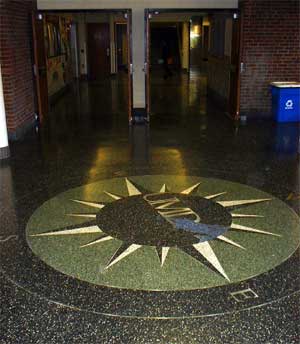 |

|
Uses of Theory (Einstein's Compass)
 When
Albert Einstein was four or five years old, his father gave him
a magnetic pocket compass to play with while he was sick in bed.
When
Albert Einstein was four or five years old, his father gave him
a magnetic pocket compass to play with while he was sick in bed.
Even as an old man, Einstein wrote of this compass with its needle always, mysteriously turning to the north, "I can still remember...that this experience made a deep and lasting impression on me. Something deeply hidden had to be behind things" (qtd in Ulmer 19).
In a study of creative thinking in the sciences, Gerald Hopkins observes that such early experiences, memories and images often trace a pattern of thinking, a turn of mind, that anticipates the discoveries and insights that these scientists make in their maturity. Hopkins calls these patterns "themata" (qtd. in Ulmer 20).
Walking into the newly renovated Kirby Plaza at UMD and thinking about teaching a unit on Digital Theory, I was surprised by this compass design in the floor, pointing to true north. It skewed my whole sense of orientation, my unconscious assumption that the hallways were true. Suddenly, the grid-lines of hallways (the grid of actual experience!) were superceded by this hidden, global grid of magnetic lines stretching invisibly beyond the horizon in unexpected, seemingly crazy directions.
I was reminded of Einstein's themata, the hidden forces behind "things," and of the uses of theory. Like the compass, theory can at first seem crazy or impossible. But it places the evidence of our eyes in a new orientation, helps us see ordinary things in an extraordinary perspective, and helps us situate ourselves in relation to a encompassing grid, or network, of transforming ideas and principles that connect the practical "here" with a bigger picture.
Work Cited
Ulmer, Gregory. Internet Invention: From Literacy to Electracy. New York: Longman, 2003.
Related Ideas on this Site
See Also
- Gregory Ulmer's Home Page, and his Images of Wide Scope.
< Back to the Ideas Site home
Please contact me about any broken links or errors, or if you have suggestions for additional links on this page.